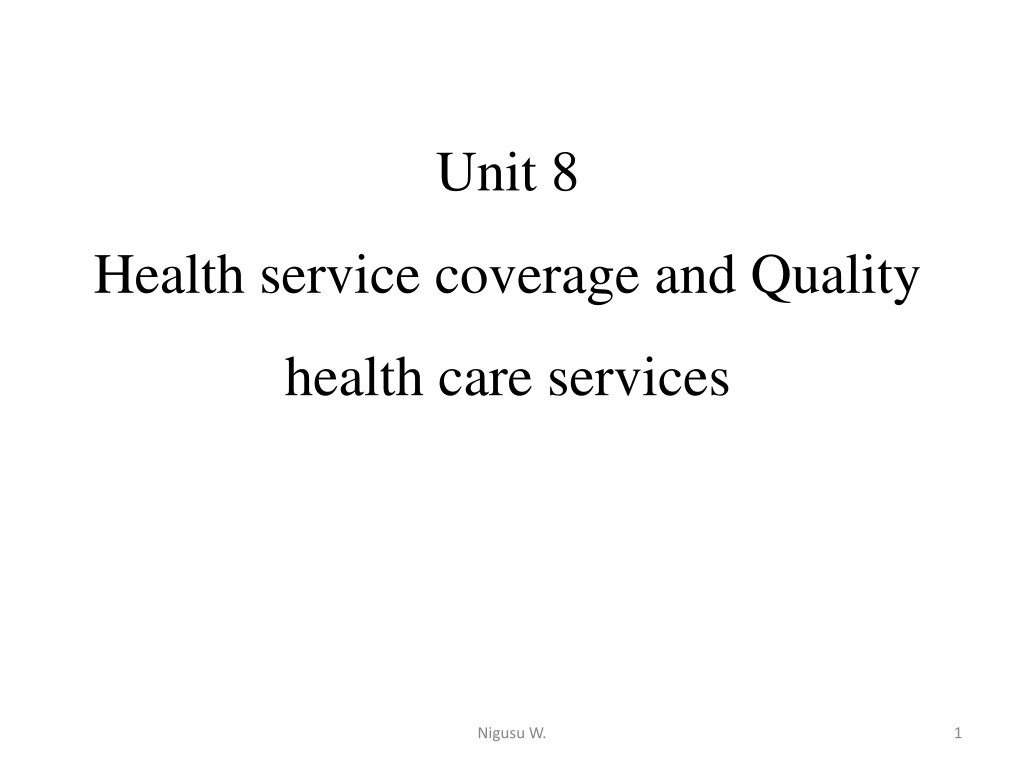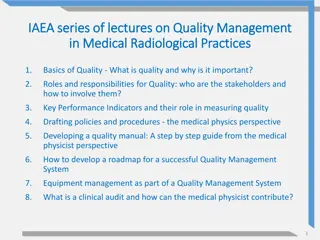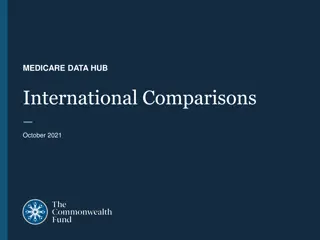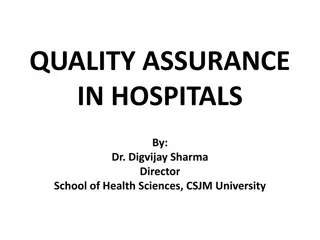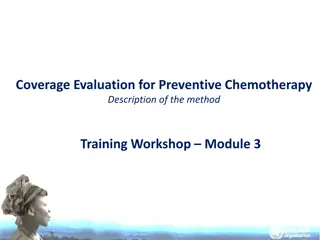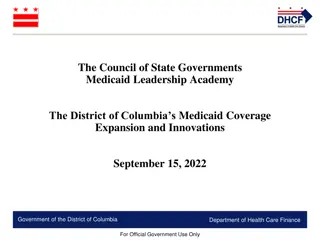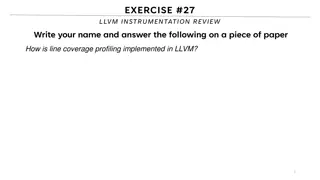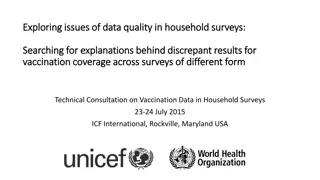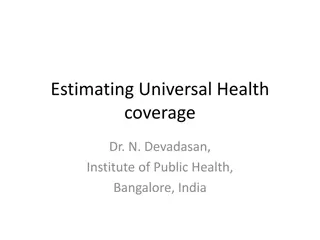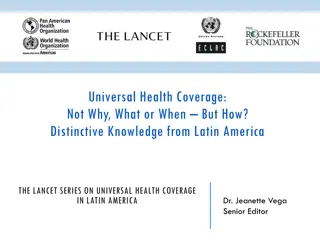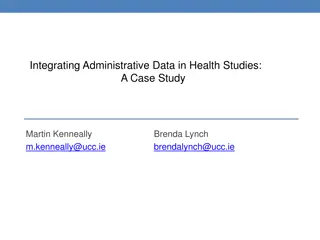Understanding Health Service Coverage for Quality Healthcare
Health service coverage plays a crucial role in ensuring access to quality healthcare for everyone. It involves interaction between services and individuals, measuring effectiveness, and resource allocation. Developing countries prioritize basic services and technology advancements. Key issues include resource allocation, effective service delivery, and meeting people's needs. Comprehensive health service coverage depends on organizational ability to engage with the target population and various factors influencing service transformation.
- Health Service Coverage
- Quality Healthcare
- Resource Allocation
- Developing Countries
- Effective Service Delivery
Download Presentation

Please find below an Image/Link to download the presentation.
The content on the website is provided AS IS for your information and personal use only. It may not be sold, licensed, or shared on other websites without obtaining consent from the author. Download presentation by click this link. If you encounter any issues during the download, it is possible that the publisher has removed the file from their server.
E N D
Presentation Transcript
Unit 8 Health service coverage and Quality health care services Nigusu W. 1
Reflective Question What is Health system ? Nigusu W. 2
Health service coverage Objectives At the end of this session students be able to o Understand what health service coverage mean o Explain different stages of health service coverage o Describe factor affecting health service coverage Nigusu W. 3
Health service coverage Health service coverage is considered as the extent of un limited interaction b/n the service and the people for whom it is intended. Nigusu W. 4
Coverage For the measurement of coverage, several key stages are first identified and defined for each stage, namely the ratio between the number of people for whom the condition is met and the target Population. Nigusu W. 5
Coverage In many developing countries high priority has been given to basic health services or primary health care. One is the development of new resources and technologies The other is the effective use of available resources and technologies Nigusu W. 6
Coverage The fundamental issues in the management of a basic health service are: How should resources be allocated and services be organized in order to serve as many people as possible? Is the service reaching the people it should serve ? Has the service been effective in meeting the people's needs? Nigusu W. 7
Comprehensive view of health service coverage Health service coverage depends on the ability of a health service organization to interact with the service users (the target population). Nigusu W. 8
Coverage This transformation process involves a variety of factors, such as availability of resources and manpower, distribution of facilities, supply logistics, and people's attitudes to health and health care Nigusu W. 9
Coverage Coverage is normally expressed by the proportion of the target population who can receive or have received the service. The number of people for whom the service can be provided expresses the service capacity or indicates the potential of the service. Nigusu W. 10
Coverage On the other hand, the number of people who have received the service indicates the service output and the actual performance of the service. It defines the coverage related to service capacity as potential coverage and that related to service output as actual coverage. The relationship between service capacity and output is called service utilization (ratio between output and service capacity). Nigusu W. 11
Coverage Utilization refers only to the service, and its measurement is only indirectly related to the size of the target population; on the other hand, coverage expresses a relationship between the service and the target population. Eg. A high utilization of service facilities does not necessarily imply satisfactory coverage and could in fact imply the contrary. Nigusu W. 12
Coverage Looking at this process from the point of view of service provision, it is possible to identify five important stages that successively lead to a desired health intervention and to define measurements of coverage appropriate to these stages. Nigusu W. 13
1. Availability coverage Some resources like manpower, facilities, drugs, etc.-are always required, the availability of such resources limits the maximum capacity of the services for target population. The ratio between this capacity and the size of the target population is called availability coverage. Nigusu W. 14
2. accessibility coverage. Even if all the necessary resources are available, the service must be located within reasonable reach of the people. Here, the capacity of the service is limited by the number of people who can reach and use it. The coverage based on this capacity called accessibility coverage. Nigusu W. 15
3. Acceptability coverage Once the service is accessible, it still needs to be acceptable to the population. This " acceptability " may be influenced by such factors as the cost of the service to the user, the form of religion he/she follows, etc. Here, service capacity is limited by the number of people who are willing to use the accessible service, and the measurement of coverage called acceptability coverage. Nigusu W. 16
4.Contact coverage This is the process of service provision or actual contact between the service provider and the user. The number of people who have contacted the service is a measurement of service output; the ratio between this and the size of the target population gives is called contact coverage. Nigusu W. 17
5. Effective coverage The contact between the service provider and the user doesn t be always guarantee for successful intervention related to the user's health problem. The measure, for number of people who have received satisfactory service is called effectiveness coverage. Nigusu W. 18
Coverage diagram-illustrating relationships between the process of service provision and coverage measurements. Nigusu W. 19
Universal health coverage UHC is defined as ensuring that all people have access to needed health services (preventive , promotive, curative, rehabilitative and palliative) in a sufficient quality and ensuring that the use of these services does not expose the users for financial hardship. Nigusu W. 20
Health care quality Objectives: At the end of this class, students will be able to: Define quality in the context of healthcare Identify perspectives in the definition and measurement of HC quality Describe the components of quality in healthcare Differentiate between different components of QM:QA,QC and QI Describe different models of quality management in healthcare: Licensing, Certification, Accreditation, CQI Nigusu W. 21
Concepts of Quality in healthcare Increasing attention to quality during the last few decades However, the concept is among those lacking standard definition and description. What constitutes quality in healthcare? What is quality of Health Care for you? Definitions depend on what people value more. Nigusu W. 22
Definitions cont IOM(1990), National Academy of Sciences Quality of health care is the degree to which health services for individuals and populations increase the likelihood of desired health outcomes and are consistent with current professional knowledge. Important concepts: Quality can be assessed both at individuals and population level Quality can be assessed from the current professional practices Nigusu W. 23
Important concepts in the definitions Quality of healthcare is about: Achieving positive health outcomes Economical/Efficient health care Limiting the negative consequences of health care(balancing risk and benefits) Complying with scientific recommendations/Current knowledge Addressing beneficiaries needs and expectations Nigusu W. 24
Components of healthcare Quality Different dimensions of health care quality by different scholars or organization But the most widely accepted being Donabedian dimension/component of quality According to Donabedian, quality of healthcare has seven pillars/components Nigusu W. 25
Efficacy Equity Effectiveness Q Legitimacy Efficiency Acceptability Optimality Nigusu W. 26
Components cont Efficacy: Is the ability of the science and art of healthcare to bring about improvement in health and well being under best circumstances. What constitutes bestcircumstances is always difficult to define and Controlling other factors is always challenging Therefore, a more realistic definition could substitute specifiedcircumstances for bestcircumstances Nigusu W. 27
Components cont Effectiveness: Is improvement in health that is achieved or expected to be achieved under the ordinary circumstance of everyday practice(Unlike efficacy-best condition). Is the degree to which attainable outcomes are attained in reality. It is the comparison between what is achieved in reality with what is potentially achievable with the best care provided. ???????? ?? ?????? ???? ?????? ??????????? ?? ?????? ???????? ???? ???? ???? Effectiveness= Nigusu W. 28
Components cont Efficiency Is measure of cost at which any given improvement in health is achieved The ability to achieve attainable outcomes of care at a lower cost. Forexample:if two efficacious or effective, the less costly one is the most efficient Improving efficiency means decreasing the cost of care without compromising achievement of maximum attainable results o Efficiency=???????? ?? ????? ???? ?????? ???? ?? ???? Nigusu W. strategies are equally 29
Components cont Optimality the balancing of improvements in health against the cost and other negative consequences of such improvements becomes relevant when the effect of care are valued not in absolute terms, but relative to the cost of care. The most advantageous balancing of cost and benefits is optimizing benefits Nigusu W. 30
Components cont Acceptability Is the level of conformity of care to the wishes, desires and expectations of patients and their families Usually related to what beneficiaries of healthcare value more including: Accessibility of care/services Patient-practitioner relationship Amenities of care(Time, expense, physical comfort to receive services) Pt preferences regarding the effectiveness & cost of care Nigusu W. 31
Components cont Legitimacy Is acceptability of care to the society or community at large. Is the conformity of healthcare to social preferences as expressed in ethical principles, values, norms, laws and regulations Is the equivalent of acceptability as applied to the society Sometimes what is best care for individuals couldn t becomes best care for the society. Society considers more issues: indirect and intangible costs; effect at society level Nigusu W. 32
Components cont Equity Conformity to a principle that determines what is just and fair in the distribution of healthcare and its benefits among members of the population Do interventions facilitate the fair distribution of health services and benefits out of health care fairly among different segments of the population? Equity is part of what makes care acceptable to individuals and society legitimate So can able to stand as separate pillar of quality Nigusu W. 33
Other dimensions of quality IOM(2001): Safety-care intended to help patient that shouldn t harm them Effectiveness: Care should be based on scientific knowledge and provided to patients who could benefit. In other words, underuse and overuse should be avoided. Patient centeredness-Care should be respectful of and responsive to individual patient preferences, needs, and values, and patient values should guide all clinical decisions Nigusu W. 34
Other dimensions of quality IOM(2001): Timeliness Care should be provided promptly when the patient needs it. Efficiency Waste, including equipment, supplies, ideas, and energy, should be avoided. Equity The best possible care should be provided to everyone, regardless of age,sex, race, financial status, or any other demographic variable. Nigusu W. 35
Other dimensions of quality Dimensions of WHO: Safe Equitable Acceptable/Patient centered Accessible Efficient Effective Nigusu W. 36
Quality management Nigusu W. 37
Quality Management: Why? Three areas of gaps in healthcare: Overuse of healthcare Underuse of healthcare Misuse of healthcare Nigusu W. 38
Services needed Services provided A B A: Underuse B: Overuse C: Misuse C: How? Nigusu W. 39
Quality Management: Why? Overuse of healthcare: Refers to providing health care for peoples who are not eligible for it. Occur when drug or treatment given without medical justification. Consequences include Direct cost of services Opportunity costs of delivering useless services Side effects of services provided without indication Examples Prescribing antibiotics for common cold or other simple infections. Nigusu W. 40
Quality Management: Why? Underuse of services Refers to Missed opportunities for provision of services(at facility level) Occurs when doctors or hospitals neglect to give patients medically necessary care or to follow proven health care practices Result in low coverage of services at population level Examples Patients with TB not tested for HIV ANC/FP clients not tested for HIV Low coverage of interventions for carcinogenic cases Mothers visiting OPD not screened for breast cancer Nigusu W. 41
Quality Management: Why? Misuse of services Inappropriate application of the science and technology of healthcare resulting in: Low effectiveness High cost Discomfort and injury to patients Examples Diagnosis Treatment mismatch, procedural/medical errors Nigusu W. 42
Quality Management: Why? In general the need for quality management increased due to: High cost of health care services Regulatory pressures Excessive variation in medical practices Growing power of the purchaser Malpractice incidents Declining morale among health care providers Nigusu W. 43
Components of QM:Quality terms QM have four componments:quality plan, quality control, quality assurance and quality improvement. 1. Quality plan: A document or set of documents that describe the standards, quality practices, resources and processes pertinent to a specific product, service or project. 2. Quality Control: is the ongoing effort to maintain the integrity of a process to maintain the reliability of achieving an outcome. 3. Quality Assurance: is the planned or systematic actions necessary to provide enough confidence that a product or service will satisfy the given requirements. 4. Quality Improvement: can be distinguished from Quality Control in that Quality Improvement is the purposeful change of a process to improve the reliability of achieving outcome. Nigusu W. 44
.Quality terms Quality Management Quality Assurance Quality Control Nigusu W. 45
.Quality terms QA Vs. QC: Although QA and QC are closely related concepts, and are both aspects of quality management, they are fundamentally different in their focus: QC is used to verify the quality of the output; QA is the process of managing for quality. Quality control is a product-oriented process;QA is a process-oriented practice. QC makes sure the end product meets the quality requirements, QA makes sure that the process of manufacturing the product does adhere to standards. QC can be noted as a reactive process;QA can be identified as a proactive process QC involves detection and correction; QA involves prevention. Nigusu W. 46
Quality Management Models There are different models of QM in healthcare: Licensing Certification Accreditation Continuous quality improvement Most of the time, countries implement a combination of these models. No single model can effectively improve healthcare quality, a combination of models is usually important. Nigusu W. 47
Licensing Licensing Is a process by which a governmental authority grants permission to an individual practitioner or health care organization to operate or engage in an occupation or profession. Licensure reflects fulfillment of minimum requirements No individual or organization can be engaged in service provision without a license. Nigusu W. 48
Certification Certification Certification reflects the capability of an individual to provide services additional to minimum requirements. Certification provides added credential to an entity s qualification. Examples. Certification of a GP to perform C/S in Ethiopia Certification of a general hospital to provide some specialized services Nigusu W. 49
Accreditation Accreditation Is a formal process by which a recognized body usually a non-governmental organization, assesses and recognizes that a health care organization meets applicable pre-determined and published standards. Participation is voluntary but advantageous Assessment involves self assessment and external assessment by a team of peers Nigusu W. 50
